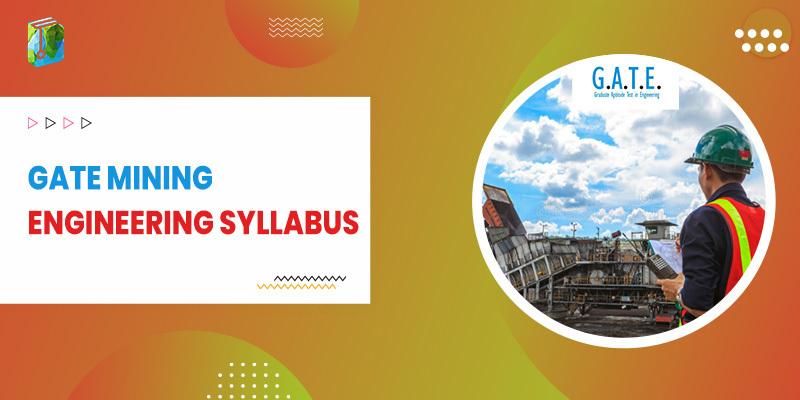Introduction
Mining engineering is an engineering discipline that applies science and technology to the extraction of minerals from the earth. Mining engineering is associated with many other disciplines, such as geology, mineral processing and metallurgy, geotechnical engineering, and surveying. GATE Mining Engineering Syllabus is very vivid and the candidates often get confused about what to study.
Therefore, we have listed the complete GATE MN Syllabus 2024 in this article.
GATE Mining Engineering Syllabus (MN) 2024
GATE Mining Engineering Syllabus (MN) Consists of Six Sections, these are:
- Engineering Mathematics.
- Mine Development and Surveying.
- Geomechanics and Ground Control.
- Mining Methods and Machinery.
- Surface Environment, Mine Ventilation, and Underground Hazards.
- Mine Economics, Mine Planning, Systems Engineering.
Section 1: Engineering Mathematics
Linear Algebra
Algebra of matrices: Inverse and rank of a matrix; System of linear equations; Symmetric, skew-symmetric and orthogonal matrices; Determinants; Eigenvalues and eigen vectors, Diagonalisation of matrices; Cayley-Hamilton Theorem.
Calculus
Functions of single variable: Limit, continuity and differentiability; Mean value theorems, Indeterminate forms and L’Hospital’s rule; Maxima and minima; Taylor’s theorem, Fundamental theorem and mean value-theorems of integral calculus; Evaluation of definite and improper integrals; Applications of definite integrals to evaluate areas and volumes.
Functions of two variables: Limit, continuity and partial derivatives; Directional derivative, Total derivative; Tangent plane and normal line; Maxima, minima and saddle points, Method of Lagrange multipliers; Double and triple integrals, and their applications.
Sequence and series: Convergence of sequence and series; Tests for convergence, Power series; Taylor’s series; Fourier Series; Half range sine and cosine series.
Vector Calculus
Gradient, divergence and curl; Line and surface integrals; Green’s theorem, Stokes theorem and Gauss divergence theorem (without proofs).
Complex Variable
Analytic functions; Cauchy-Riemann equations; Line integral, Cauchy’s integral theorem and integral formula (without proof); Taylor’s series and Laurent series; Residue theorem (without proof) and its applications.
Ordinary Differential Equation
First-order equations (linear and nonlinear); Higher order linear differential equations with constant coefficients; Second-order linear differential equations with variable coefficients; Method of variation of parameters; Cauchy-Euler equation; Power series solutions; Legendre polynomials, Bessel functions of the first kind and their properties.
Partial Differential Equation
Classification of second-order linear partial differential equations; Method of separation of variables; Laplace equation; Solutions of one-dimensional heat and wave equations.
Probability
Axioms of probability; Conditional probability; Bayes’ Theorem; Discrete and continuous random variables: Binomial, Poisson, and normal distributions; Correlation and linear regression.
Numerical Methods
Solution of systems of linear equations using LU decomposition, Gauss elimination and Gauss-Seidel methods; Lagrange and Newton’s interpolations, Solution of polynomial and transcendental equations by Newton-Raphson method; Numerical integration by trapezoidal rule, Simpson’s rule and Gaussian quadrature rule; Numerical solutions of first-order differential equations by Euler’s method and 4th order Runge-Kutta method.
Section 2: Mine Development and Surveying
Mine Development: Methods of access to deposits; Underground drivages; Drilling methods and machines; Explosives, blasting devices, and practices.
Mine Surveying: Levels and leveling, theodolite, tacheometry, triangulation; Contouring; Errors and adjustments; Correlation; Underground surveying; Curves; Photogrammetry; Field astronomy; EDM and Total Station; Introductory GPS.
Section 3: Geomechanics and Ground Control
Engineering Mechanics: Equivalent force systems; Equations of equilibrium; Two-dimensional frames and trusses; Free body diagrams; Friction forces; Particle kinematics and dynamics; Beam analysis.
Geomechanics: Geo-technical properties of rocks; Rock mass classification; Instrumentation and stress measurement techniques; Theories of rock failure; Ground vibrations; Stress distribution around mine openings; Subsidence; Rock bursts and coal bumps; Slope stability.
Ground Control: Design of pillars; Roof supporting systems; Mine filling.
Section 4: Mining Methods and Machinery
Mining Methods: Surface mining: layout, development, loading, transportation and mechanization, continuous surface mining systems; Underground coal mining: bord and pillar systems, room and pillar mining, longwall mining, thick seam mining methods; high wall mining; Underground metal mining: open, supported and caved stoping methods, stope mechanization, ore handling systems.
Mining Machinery: Generation and transmission of mechanical, hydraulic and pneumatic power; Materials handling: haulages, conveyors, face and development machinery, hoisting systems, pumps, crushers.
Section 5: Surface Environment, Mine Ventilation, and Underground Hazards
Surface Environment: Air, water, and soil pollution: Standards of quality, causes and dispersion of contamination, and control; Noise; Land reclamation.
Mine Ventilation: Underground atmosphere; Heat load sources and thermal environment, air cooling; Mechanics of airflow, distribution, natural and mechanical ventilation; Mine fans and their usage; Auxiliary ventilation; Ventilation planning; Ventilation networks.
Subsurface Hazards: Mine Gases. Underground hazards from fires, explosions, dust and inundation; Rescue apparatus and practices; Safety in mines; Accident data analysis; Mine lighting; Mine legislation; Occupational safety.
Section 6: Mine Economics, Mine Planning, Systems Engineering
Mine Economics: Mineral resource classification; Discounted cash flow analysis; Mine valuation; Mine investment analysis; Mineral taxation.
Mine Planning: Sampling methods, practices and interpretation; Reserve estimation techniques: Basics of geostatistics and quality control; Optimization of facility location; Work-study.
Systems Engineering: Concepts of reliability; Reliability of simple systems; Maintainability and availability; Linear programming, transportation and assignment problems; Network analysis; Inventory models; Queueing theory; Basics of simulation.
Click Here to Download GATE Mining Engineering Syllabus (MN) in PDF.
Conclusion
This article explains to you the detailed syllabus of the GATE Mining Engineering examination. Every competitive examination needs a diligent analysis of its syllabus. You must prepare religiously as it is a complex field.
Appear for as many mock tests as possible. It helps you to understand your weak and strong areas.
Maintain consistency and follow a healthy routine.
Good luck!

